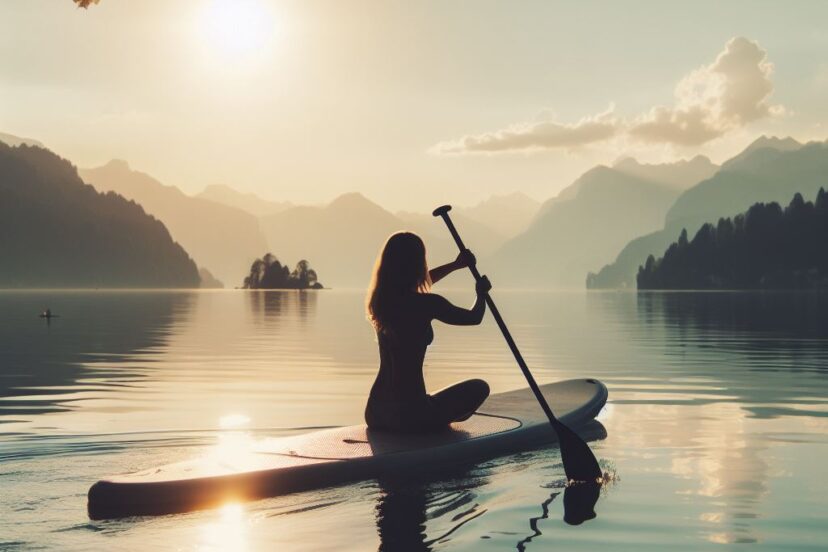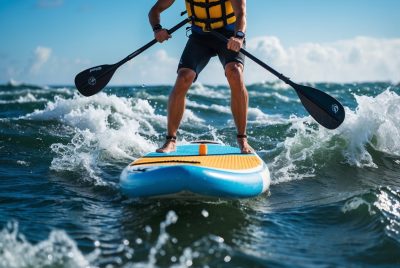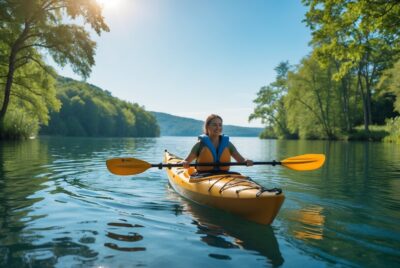Paddle Boarding: The Ultimate Guide for Enthusiasts
*We may earn a commission for purchases made using our links. Please see our disclosure to learn more.
Paddle Boarding: An Adventure on the Water
Introduction to Paddle Boarding
Let’s embark on an exhilarating journey into the world of paddle boarding, a captivating water sport that offers a unique blend of excitement, fitness, and tranquility. As a passionate paddle boarder and enthusiastic guide, I’m thrilled to share my insights and expertise with you. In this all-encompassing guide, we’ll delve deep into the realm of paddle boarding, from selecting the ideal gear to mastering the art of gliding gracefully across the water.
If the water calls out to you, paddle boarding may just be the answer. Stand-up paddle boarding (SUP) offers a unique blend of adventure, fitness, and peace that captivates many. It’s an accessible sport, perfect for any age and skill level, and you can take it as easy or as challenging as you like.
What is Paddle Boarding?
Paddle boarding, often referred to as stand-up paddleboarding (SUP), is a thrilling water sport that involves standing on a long, stable board and using a paddle to propel yourself across the water. Unlike traditional surfing, where you ride waves lying down, paddle boarding offers a versatile and engaging experience that can be enjoyed on various types of water bodies, from serene lakes and gentle rivers to the crashing waves of the ocean.
The primary equipment for paddle boarding includes a paddle board, a paddle, and a personal flotation device (PFD), such as a life jacket. The board itself comes in different shapes and sizes, catering to various skill levels and preferences.
Brief History of Paddle Boarding
Paddle boarding’s lineage can be traced to ancient Polynesian cultures and was popularized in modern times by Hawaiian surf instructors. It’s a heritage sport that has gained modern popularity, now enjoyed in water bodies worldwide.
Getting Started with Paddle Boarding
To start your SUP journey, the first step is choosing the right equipment. As a beginner, stability is your best friend, so opt for a wider board. An adjustable paddle will ensure you can find a length that suits your height for a comfortable paddling experience.
Choosing the Right Paddle Board
Your choice in boards will vary based on intended use: all-around, touring, racing, fishing, yoga, and surf paddle boards are some of the options available. Beginners should start with an all-around board for its versatility and stability.
Essential Gear
Essential gear includes a paddle, personal flotation device, leash, water-resistant sunscreen, and perhaps a waterproof bag for personal items. Clothing will depend on the climate but generally involves a wetsuit or UV-protective gear.
Basic Techniques and Tips
Mastering the basics involves knowing how to balance on the board, learning efficient stroke techniques, and understanding how to maneuver. Practicing on calm water can help you get comfortable before moving to more challenging environments.
Advanced Paddle Boarding Skills
Progress to advanced skills like quick turns, using footwork for better maneuverability, and handling various water conditions. Remember, the key to advancement in SUP is a mixture of practice and pushing your comfort zone with new techniques and environments.
Fitness and Health Benefits of Paddle Boarding
SUP is an excellent full-body workout. It engages your core, improves balance, offers cardiovascular benefits, and can be a meditative form of stress relief. Regular practice can lead to significant improvements in physical and mental health.
Paddle Boarding for Adventure and Exploration
Exploring through SUP is exhilarating. It allows access to remote waterways, up-close encounters with marine life, and the chance to see landscapes from a new perspective. Always prioritize safety by knowing the area and weather conditions before heading out.
Paddle Boarding with Others
Paddle boarding can be social, too. Families can enjoy it as a bonding activity, and it’s a fun way to introduce kids to water sports within the safety protocols. SUP is also becoming a popular way to take pets out onto the water, with special gear available to ensure their comfort and safety.
Paddle Boarding Gear and Maintenance
Taking care of your gear is crucial. Rinse your board and paddle after each use, check regularly for dings and wear, and store them in cool, dry places. Proper maintenance will extend the life of your equipment and enhance your paddling experience.
Overcoming Common Challenges
Challenges like adverse weather, fatigue, and potential injuries can be managed with preparation and knowledge. Learning to read weather conditions, pacing yourself, and having a basic understanding of first aid will go a long way in ensuring a safe SUP experience.
Making the Most of Your Paddle Boarding Experience
There are many ways to make it a richer experience. Joining a community, participating in events, and trying out SUP yoga or nighttime paddling can all add variety and excitement to your practice.
Conclusion: Why Paddle Boarding Could Be Your New Passion
With a mix of tranquility and exercise, it is a rewarding activity that offers something for everyone. It encourages a healthy lifestyle, provides an outlet for exploration, and is a platform for social activities. Try it, and you may just find a new passion that’s both invigorating and peaceful.
FAQs
- How do I choose the right size paddle board? Start with a board that’s at least 10 feet long and 30 inches wide for stability.
- Is it difficult to learn? It’s user-friendly; most beginners get the hang of it after just a few tries.
- What should I do if I fall off ? Stay calm, keep hold of your paddle, and climb back on from the side.
- Can it help with weight loss? Absolutely, it’s an efficient full-body workout that burns calories.
- Where can I find classes? Check local water sport centers, lakeside businesses, or community boards for classes.




